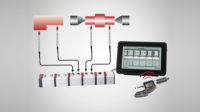A reader asked me to comment on a situation he faced regarding calibration frequency for some gages he had on loan from his customer. The gages are only used once a year for this specific customer and—I’m guessing—spend about 80% or more of the year doing nothing.
The problem with this situation is that the customer has a three month calibration cycle, which makes sense when they are in continuous use. But he insists on it being followed while my reader has the gages in his possession despite the fact that they may not be used at all over two or more cycles.
My reader is expected to pay for this calibration but his customer is unable or unwilling to adjust the calibration frequency to the current situation. Situations like this pop up quite often so it’s worth looking at what is required from a technical point of view.
The concept that covers calibration cycles is fairly simple: they have to ensure that whatever you’re using is within its working limits for the task at hand. Discovering the gage or instrument is out of tolerance after parts have been produced is not an option. Re-calibration intervals or cycles have to catch such conditions beforehand. You could call it another form of damage control.
There are a number of elements that have to be considered in establishing a calibration cycle including how often the device(s) are being used, who is using them, where they are being used, the work tolerances involved, and the materials they will be in contact with. The basic design and construction of the device are major factors in addition to whether there is any interim monitoring in the system. And while it seems that it’s not very common any more, plain old common sense can be a major consideration.
Economics is another consideration since overly frequent calibration can be costly. On the other hand, infrequent calibration could result in rejected parts and the costs of making things right will often exceed calibration costs by a wide margin.
If you are putting a new gage into service you can use the knowledge from those you may already be using as the basis for establishing a calibration cycle. This assumes that the conditions of use are identical which can make copying cycles used by other companies a bit iffy at times. This is also why asking your calibration provider for advice can be risky since they rarely know much about your specific situation. Consider any information they give you as a starting point if you don’t have historical information to work with.
When starting from scratch take your best estimate and reduce it by, say, 50%. This will mean overkill in most cases but after you have gone through a few cycles, you’ll have data that can be used to increase or decrease the frequency.
This is what I suggested to my reader who is trying to resolve an overkill situation: Take the data he already has and present that to his customer to justify lengthening the cycle on the gages. Another suggestion is to get his customer to forgo the rigid schedule by getting the gages calibrated prior to their use each year. This would have to be done far enough ahead of the production start date to allow for their replacement if calibration rejects them.
Compare calibration data over a couple of cycles particularly when fixed limit gages are involved to see where a gage is trending within your established limits. It could be so close to limit that it wears out way before the next calibration. If this risk is present, shorten the cycle temporarily to prevent this from happening and get a replacement on order.
If you are using time as a guiding factor for cycles remember to start the clock from date of first use rather than when you received the gage. If you don’t do this, your first calibration could be very short due to start up situations that can take many weeks or months before actual use begins.
When you consider the various factors that go into setting up calibration cycles remember that one size doesn’t fit all. Keep on top of it by ensuring that they are reviewed any time a change is made to one or more of the factors noted earlier.



